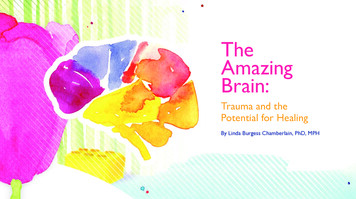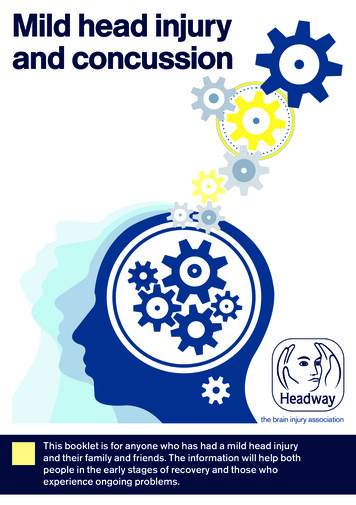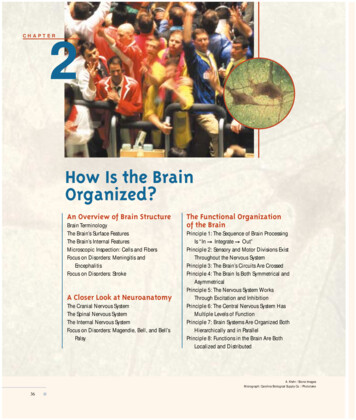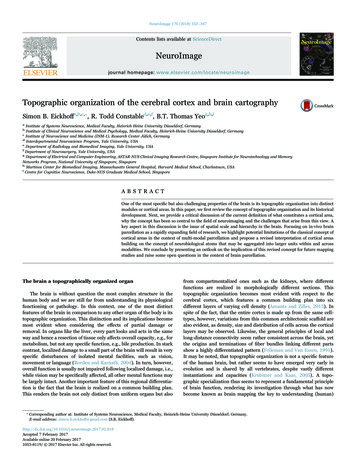
Transcription
About the brainHeadway’s publications are all available to freely download from the informationlibrary on the charity’s website, while individuals and families can request hard copies of thebooklets via the helpline.Please help us to continue to provide free information to people affected by braininjury by making a donation at www.headway.org.uk/donate. Thank you.Brain facts The average human brain weighs about 3lbs, or around 1.5kgIt has the texture of blancmangeThe brain is connected to the spinal cord by the brain stemBehind the brain stem is the cerebellumThe cerebral cortex is the largest part of the brain. It contains the frontal, parietal,temporal and occipital lobes, as well as the motor and sensory cortexThe brain is made up of around 100 billion nerve cells and even more support cells,which provide nourishment to the nerve cellsThe diagram below shows which areas of the brain control different activities:1 Headway - the brain injury association, 2006
Damage to a particular area can affect that activity. A stroke tends to affect a specific areaof the brain, whereas a head injury due to for example, a road traffic accident, usuallyinvolves more general damage.We also know that the left side of the brain controls the right side of the body. So ifsomeone had a stroke which affected the left side of the brain, it would be likely that theright side of their body would be affected.For most of us, the left side of the brain controls language, while the right side controls ourmore artistic abilities, such as drawing and music.Cerebral cortexThe largest part of the brain is known as the cerebral cortex and is shaped like a largewrinkled walnut. It is divided into two halves and joined by a bridge in the middle, referredto as the corpus callosum. The two halves are known as the right and left cerebralhemispheres. The right hemisphere controls the left side of our body and the lefthemisphere controls the right side of our body.Damage only to the right side may affect movement in the left arm and leg or hearing inthe left ear. There is also evidence that for most people the left hemisphere contains thelanguage centres involving speech, while the right hemisphere tends to control nonlanguage, spatial skills such as drawing or musical ability.If a person receives injuries only to the left side of the brain, by for example, having astroke, it is likely that speech would be affected, as would the ability to move the right sideof the body.As well as dividing into a left and right hemisphere, the cerebral cortex can be furtherdivided into a number of areas, known as lobes:Frontal lobeThe frontal lobe is the area behind the forehead and is heavily involved in intellectualactivities such as planning and organising, as well as being involved in personality and thecontrol of emotions and behaviour.Motor and sensory corticesBetween the frontal and parietal lobes is the motor cortex which controls movement andthe sensory cortex which controls sensation.Parietal lobesLocated behind the frontal lobe, at the back of the brain above the ears, these have animportant role to play in our ability to understand spatial relationships (e.g. the distancebetween two objects).2
Temporal lobesNestled behind the ears, this area holds the bulk of our memories and our ability tounderstand things and speak.Occipital lobeAt the very back of the head, behind the parietal lobes, are the occipital lobes, which areresponsible for vision. Any injury to this area can cause partial or complete blindness.Internal areas of the brainHidden in the middle of this walnut-like cerebral cortex are a number of small white nervecentres, collectively known as the diencephalon. In this area lies the small pea-sizedhypothalamus, which controls appetite regulation, sexual arousal, thirst and temperaturecontrol, and some aspects of memory.3
Close to this area is another important set of nuclei, referred to as the limbic system.Damage to this area can disrupt emotional regulation, leaving the individual with dramaticand sudden mood swings.Cranium and brain stemThe brain is completely surrounded by a hard, protective, rounded shell of bone, known asthe skull or cranium. The important thing to remember about the skull is that underneaththe front, there are a number of bony ridges. When the soft tissue of the brain is shakenaround, these ridges have the unfortunate effect of lacerating and damaging the undersideof the front of the brain.On the floor of the skull is a hole where the lower part of the brain or brain stem isconnected to the spinal cord, and from there to the whole of the nervous system and therest of the body. The brain stem is rather like a thick telecommunications cable, withcountless nerve fibres, like wires, carrying messages backwards and forwards. It is alsoknown to control bodily functions such as wakefulness, consciousness, tiredness,heartbeat and blood pressure. Damage to this area is thought to cause concussion andloss of consciousness.Texture and blood vesselsThe texture of the brain is rather like soft blancmange, but is held together in the skull bythree layers of membrane called the dura mater (closest to the bone), arachnoid (middlelayer) and pia mater (closest to the brain). These layers are collectively referred to as themeninges.Between the pia and arachnoid membranes is the subarachnoid space, where the bloodvessels supplying and draining the brain pass through. Like any organ, the brain isdependent on blood from the heart, and is criss-crossed by a network of large arteries,which divide into progressively smaller branches. When the brain is shaken about in ahead injury, these vessels tear and bleed. As people get older, the blood vessels becomemore brittle and more likely to tear if shaken around. This bleeding leads to a build-up ofblood clots, which pressurises and damages the delicate tissue of the brain.The brain in its membranous sack floats in a sea of cerebrospinal fluid, which fills in all thegaps around the brain and offers some protection and cushioning. Just behind the brainstem sits a curved lump of tissue called the cerebellum. This area regulates all of aperson’s fine motor co-ordination, which is involved in skills such as balancing, movingquickly and gracefully, dancing, threading a needle, or climbing a ladder.4
Nerve cellsThe make up of the brain consists of billions of microscopic nerve cells. Under a powerfulmicroscope these cells look like small dots with a network of hair like tentacles, referred toas axons and dendrites. They communicate with each other by passing electrical andchemical impulses between these tentacles. Highly complex patterns of communication, orpathways, build up as the brain develops throughout childhood.The effect of a head injury on this delicate substance is similar to that of vigorouslyshaking a plate of blancmange - it shears and tears, disrupting those pathways ofcommunication.To discuss any issues raised in this factsheet, or to find details of our local groupsand branches, please contact the Headway helpline free of charge on 0808 800 2244(Monday - Friday, 9am-5pm) or by email at helpline@headway.org.uk.You can also find more information and contact details of groups and branches onour website at www.headway.org.uk/supporting-you.Factsheet first published 2006. Last reviewed 2019. Next expected review 2021.5
1 Brain facts The average human brain weighs about 3lbs, or around 1.5kg It has the texture of blancmange The brain is connected to the spinal cord by the brain stem Behind the brain stem is the cerebellum The cerebral cortex is the largest part of the brain. It contains the frontal, parietal, temporal and










